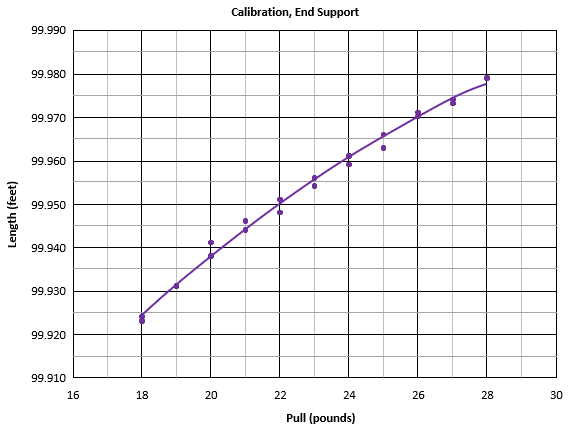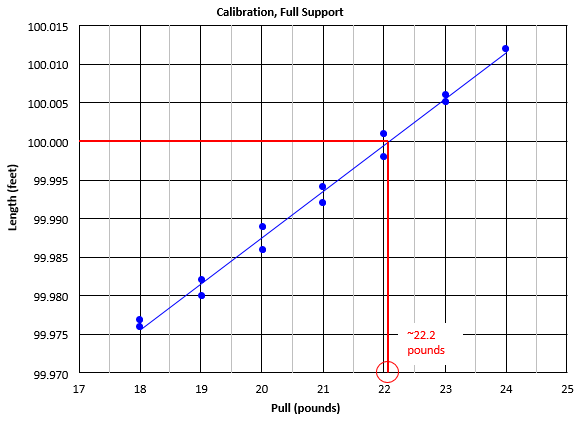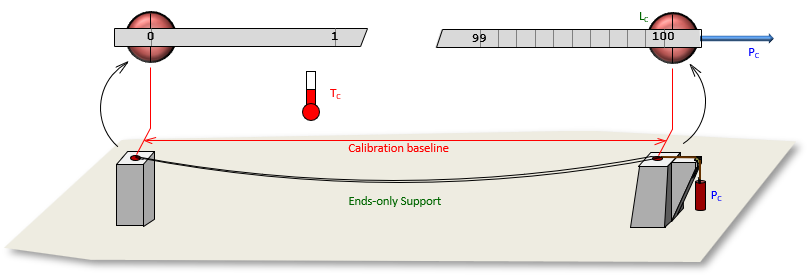C. Tape Calibration
1. General
a. When is a 100 foot tape exactly 100 feet long?
The material characteristics of a tape lead to systematic errors when it is used. These errors can be eliminated by procedure or computation. However, to do this requires tape calibration to determine its length under specific conditions. Knowing how much use conditions differ from calibration allows error control or compensation.
b. Primary conditions
(1) Temperature
Changing the temperature, Figure C-1, will cause a tape to shrink (cold) or expand (warm).
 |
| Figure C-1 Temperature Effect |
(2) Pull
Insufficient pull (tension) will not stretch out the tape sufficiently, too much will over stretch it, Figure C-2
 |
| Figure C-2 Pull Effect |
(3) Sag
When the tape ends are held up with no intermediate support, Figure C-3, its weight will cause sag, drawing the two ends closer together.
 |
| Figure C-3 Sag Effect |
2. Calibration Procedure
Theoretically, under some combination(s) of of temperature, pull, and support, a tape will be 100.00 ft long. Calibration determines a tape's length under controlled temperature, pull, and support. Deviation from calibration conditions introduces systematic errors. Knowing a tape's material properties, calibration information, and use environment allows the errors to be corrected.
Calibration consists of comparing the measuring device against a base line of higher accuracy.
a. Full support
The tape is mounted so its 0 mark lines up with one end of the base line and is fully supported along its entire length. Temperature is taken along the support surface during the calibration process.
At the other end, weight is incrementally added increasing the pull. At each weight step, the tape length is is determined with a with a micrometer reading system against the other end of the base line, Figure C-4.
|
|
| Figure C-4 Fully Supported |
Pull begins with the tape less than 100 feet long and is increased until the tape is more than 100 feet long. The process is reversed by incrementally removing weight and measuring the length.
The relationship between pull and length is linear. The weights are plotted against lengths and a straight line fit to the data. It doesn't fit perfectly because of, you guessed it, random errors. From the graph, the pull required to make the tape 100.00 feet long can be determined. In most cases, it would be an odd amount or possibly too high to comfortably use in the field. Figure C-5 shows a tape's calibration plot and line fit.
|
|
| Figure C-5 Fully Supported Calibration Data |
From the graph, the tape is 100.00 feet long at approximately 22.2 pounds of pull. A tension handle in the field may be easier to hold at 20 pounds than trying to achieve 22.2. At 20 pounds, the tape is 99.987 feet long, 0.013 ft short, an error of approximately 1/7700. That error can also be mathematically compensated.
b. End Support
Supporting a tape at only its ends introduces sag. Sag is a systematic error, a function of tape weight and pull, and can be compensated mathematically. Because of this, end-only support is not always included as part of a tape's calibration. If it is, the process is similar to full support except the tape is elevated along its length, supported only at its ends, Figure C-6.
|
|
|
Figure C-6 |
Air temperature is taken during calibration. When a tape is only supported at its end, pull is used to stretch the tape and decrease sag. Increasing the tension, however, doesn't fully eliminate sag, at least not within what a surveyor could apply in the field.
The sagged tape approximates a parabolic curve (a catenary, actually) which is a second-degree polynomial. Pull is incrementally increased, tape length is measured, and results plotted, Figure C-7. Between stretching the tape and reducing sag, pull is not related linearly to tape length so the data will not approximate a straight line.
 |
| Figure C-7 Ends Only Calibration Data |
For a heavy tape, the length may not reach 100.00 ft under a reasonable amount of pull. In the case of the calibration data in Figure C-7, at 28 pounds of pull the tape is still about 0.022 feet short of 100.00 feet. How much pull would be needed to reach 100.00 ft? No doubt more than practically possible in the field.
c. Tape properties
In addition to the calibration conditions, physical and material properties of the tape are needed to apply corrections. These include:
- Cross-sectional area
- Weight
- Thermal expansion coefficient
- Modulus of elasticity
The first two can be measured, the last two are functions of the tape material.
Thermal expansion coefficient is the amount a material expands or contracts per degree of temperature change. The coefficient of steel used in tapes is 6.5x10-5 ft/ft per degree Fahrenheit or 1.5x10-5 m/m per degree Centigrade. A 20°F temperature increase will cause a 100 ft steel tape to lengthen 0.013 ft. An invar tape has a coefficient of 2.0x10-7 ft/ft per °F or 3.6x10-7 m/m per °C so it is less sensitive to temperature changes.
Modulus of elasticity (a.k.a. Young's Modulus) is a the maximum tensil pressure that can be exerted on an object that once removed, the object will return to its original size. Exceeding the modulus will cause material to stretch and deform. The modulus for tape steel ranges between 2.8x107 and 3.0x107 pounds per square inch (psi) or 2.1x106 kilograms per square centimeter.


